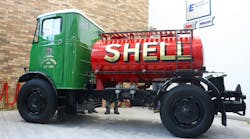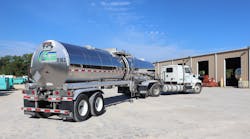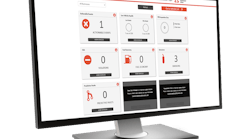Whether the fleet is company-owned or outsourced, or large or small, every tank truck carrier can use helping controlling costs.
That is why more and more fleet managers are turning to telematics as an effective solution for managing their fleets within limited budgets. When properly implemented, GPS vehicle tracking systems can generate positive results in many areas, including employee productivity, driver safety, and the ability to help lower operational expenses.
When telematics systems are implemented, fleet managers gain new visibility into outstanding or hidden maintenance issues. Telematics systems can provide information about fault codes, helping to prevent small issues from becoming a big repair problem. The system can also be used to keep maintenance on schedule, track idle time, and monitor operator performance.
Some telematics systems include features that can deliver real‐time insights for fleet asset management to improve the health, safety, and performance status of commercial vehicles. This can include remote diagnostics, alerts, action plans, health and safety scoring, and other actionable vehicle information.
This feature monitors the health of a company’s vehicles, providing an analysis of their status and issues. The user can see what vehicle it is, VIN ID, performance of health, safety issue, odometer, engine hours, and actual location. This information is pulled every few minutes and allows the user to see the SPN code, what the code means, and what could happen if it goes untreated.
A system like this enables real‐time decision-making of how to handle tank truck malfunctions to avoid engine failure. With this insight, the user knows the exact diagnosis so that they can decide what action to take, whether to bring a vehicle back to the shop or to recommend immediate shutdown.
With the information being provided to the shop in real time, mechanics can be proactive in ordering and stocking parts that can get vehicles back on the road faster and generating revenue. Mechanics can also download an app and have the information readily available to them so that they no longer have to be tethered to their desk.
The system enables the user to set their own alerts specific to what is important to the user and/or their mechanics. Usually these are used for events that are critical; the user can also set a specific fault code and customize how they want to receive that alert.
Keeping these items on a schedule helps the mechanic manage their day more efficiently and gives them the ability to schedule more effectively and be more productive. They no longer have to run reports at the end of the day; the system takes care of it all.
Command Alkon offers an Engine Data Alerts & Analysis (EDAA) feature with its Telematics and Fleet Management solution. This module delivers real-time insights for fleet asset management that improve the health, safety, and performance of commercial vehicles.
Engine Data Analysis & Alerts also provides the fleet management staff with insight into what is going on with the vehicle directly from a mobile device, allowing employees to analyze the issue and determine whether diagnostic testing is required. The ability to triage vehicles on the fly saves mechanics time and increases productivity by making sure focus is put on trucks that need servicing.
Tank truck user
One trucking company, 37 Trucking, has three divisions within their trucking services: Pneumatic, Aggregate, and Heavy Haul. The Pneumatic division delivers fly ash and powder cement in dry bulk trailers. The company’s fleet of 83 trucks relies on technology to keep operations up to speed, and their customer service up to par.
The first technology solution that 37 Trucking implemented was a Quoting, Dispatching, and Billing solution for their aggregate hauling operations. The product includes an estimating system, which then flows into dispatch and into their billing system. Before the implementation, their dispatch and drivers worked completely from Excel sheets.
They are still a fairly young hauling company, but they are enjoying growth at a very fast rate and are delivering aggregates from a wide variety of locations. With a higher volume of demand, they needed a better way to keep track of their orders. Now, they have more than 5,000 jobs in their automated dispatching and billing system, not counting sub-jobs. Imagine keeping up with an Excel spreadsheet for 5,000 jobs? Their dispatch and drivers would be lost without technology now.
Visibility at all times
In 2015, 37 Trucking implemented Command Alkon’s telematics system to capture information on the location of their trucks, fuel consumption, travel speed, and driver clock in and clock out. Now, they can track driver work hours, hours and volume per trip, per customer, per truck, and per project. They can also determine the productivity of their trucks. All of the data generated by their telematics system also feeds back to their reporting in their dispatch system.
Dispatch and drivers now communicate via 2-way messaging and dispatchers can make more informed decisions instantaneously by watching the trucks on the map and letting the driver know where to go to get their next load.
Their Director of Transportation, Paul Hardison, says that the most impactful piece of the telematics solution is the Driver Performance module, which delivers driver performance measurement and scoring capabilities to improve safety and promote cost and emissions savings. The module allows driver goals to be set and evaluated based on alerts, engine events, status timers, payroll exceptions, and more. Driver goals are aggregated to provide visibility to individual driver performance in comparison to overall fleet performance.
“My two biggest expenses are fuel and labor, and as soon as we turned Driver Performance on, the driver started to see an alert for hard acceleration and hard braking,” Paul said. “We gained 4.2% in fuel mileage because drivers were getting an alert, prompting them to drive safer and more efficiently.”
Maintenance made easy
37 Trucking recently implemented an Engine Data Alerts & Analysis (EDAA) feature in their Telematics system. This module delivers real-time insights for fleet asset management that improve the health, safety, and performance status of their trucks.
The system features include remote diagnostics, alerts, action plans, health and safety scoring, and other actionable vehicle information. Their mechanics love receiving alerts for when a truck needs maintenance before it becomes an issue.
They also receive email alerts when there is an issue with a vehicle. The system enables them to have preventive maintenance schedules in place, ensuring they can identify issues quickly and stay current on routine service tasks. They receive an automatic report each morning notifying the mechanics of what vehicles need to be worked on that day, what maintenance is coming due, and what is overdue and needs to be attended to immediately.
The EDAA feature also enables their mechanics to discern whether or not a vehicle should close up shop or stay on the road, creating more revenue. For example, if a driver calls in to notify mechanics their “check engine” light is on, but the issue is not severe enough for the shop to get notified via email, then they have the ability to quickly make the decision on whether the driver should come by the shop or continue with their orders for the day.
Should a truck on the job need servicing, EDAA functionality can provide a map of the truck’s exact location so dispatch doesn’t have to manually track the truck, find it on the phone, drop a pin, etc. They instantly have the truck’s location and can come to the rescue.
EDAA also provides fleet management staff with insight into what is going on with the vehicle directly from a mobile device. They can analyze the issue and determine whether or not they need to perform diagnostic testing. The ability to triage vehicles on the fly saves the mechanic time and increases productivity by enabling them to focus on trucks that need servicing, and all have the parts ready when the truck reaches the shop.
“We’re working on trucks when they’re not generating revenue,” Paul said. “We can work on them at the end of the day while they are shut down. Having that visibility creates an enormous ability to maintain our trucks, keep them operational, keep them on the road as much as we possibly can, and plan ahead.”
For more information, visit www.commandalkon.com/gettrackit.









